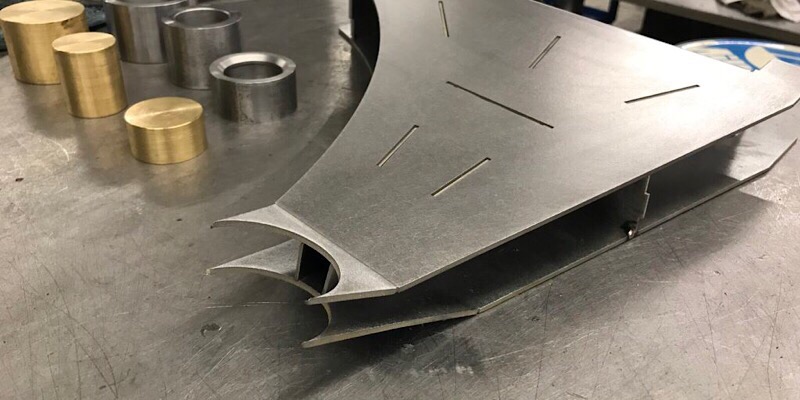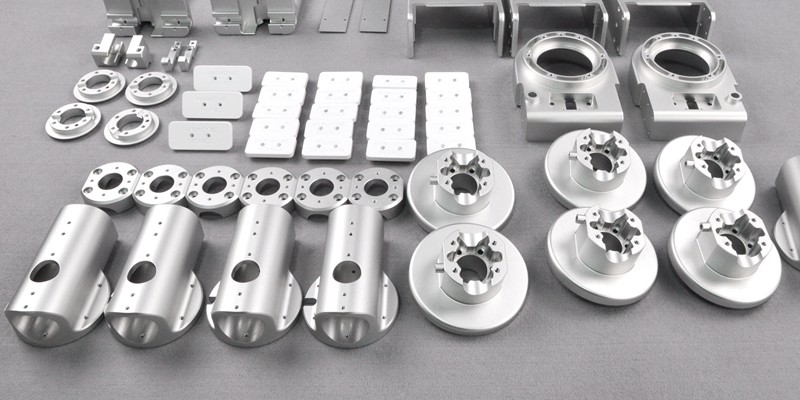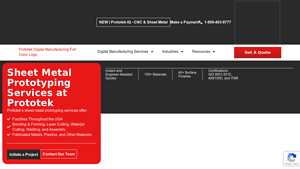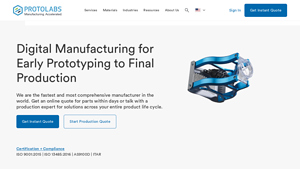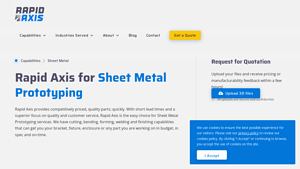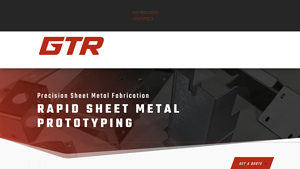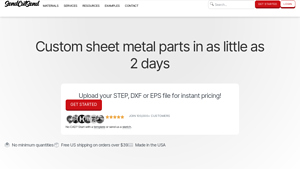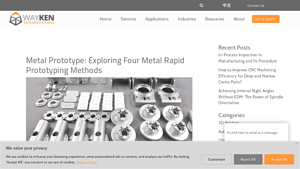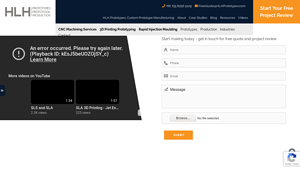Rapid Sheet Metal Prototypes Guide: Type, Cost, Top List…
Introduction: Navigating the Global Market for rapid sheet metal prototypes
In an increasingly competitive global market, sourcing rapid sheet metal prototypes presents a critical challenge for businesses looking to innovate and reduce time-to-market. As companies strive to bring their products to life efficiently, understanding the nuances of rapid sheet metal prototyping becomes essential. This guide delves into the various types of rapid sheet metal prototypes available, their applications across diverse industries, and the key factors to consider when selecting suppliers.
International B2B buyers, particularly from regions such as Africa, South America, the Middle East, and Europe, will find actionable insights that empower informed purchasing decisions. From evaluating the cost structures and lead times to understanding compliance and quality certifications, this guide provides a comprehensive overview that addresses the unique needs of global buyers.
By exploring the latest advancements in manufacturing technologies and materials, as well as best practices for supplier vetting, readers will be equipped to navigate the complexities of the sheet metal prototyping landscape. Ultimately, this guide aims to streamline your sourcing process, enabling you to partner with the right suppliers and drive successful product development initiatives.
Understanding rapid sheet metal prototypes Types and Variations
| Type Name | Key Distinguishing Features | Primary B2B Applications | Brief Pros & Cons for Buyers |
|---|---|---|---|
| Laser Cutting | High precision, minimal heat-affected zones | Aerospace, automotive, electronics | Pros: Excellent cut quality, fast turnaround. Cons: May require post-processing for thicker materials. |
| Water Jet Cutting | Versatile, can cut thick materials with high accuracy | Industrial components, prototypes | Pros: No heat distortion, suitable for various materials. Cons: Slower than laser cutting for thin sheets. |
| CNC Machining | Computer-controlled for high precision and repeatability | Custom parts, complex geometries | Pros: High tolerances, suitable for low to medium volumes. Cons: Higher initial setup costs. |
| Photo Chemical Etching | Produces complex flat parts without tooling | Electronics, medical devices | Pros: Cost-effective for small runs, high accuracy. Cons: Limited to thin materials and simple geometries. |
| Specialty Stamping | Custom tooling for intricate designs | Automotive, consumer products | Pros: Fast production of complex shapes. Cons: Tooling costs can be high for short runs. |
What are the Key Characteristics of Laser Cutting in Rapid Sheet Metal Prototyping?
Laser cutting is favored for its precision and speed, making it ideal for creating intricate designs with minimal thermal impact. It utilizes focused laser beams to cut through various sheet metal types, including stainless steel and aluminum. This method is particularly suitable for industries like aerospace and automotive, where accuracy is paramount. Buyers should consider the thickness of materials and potential post-processing needs, especially for thicker sheets.
How Does Water Jet Cutting Differ from Other Methods?
Water jet cutting employs a high-pressure stream of water mixed with abrasive particles to slice through materials. This technique is versatile, capable of handling thick metals without causing heat distortion, making it ideal for industrial components and prototypes. While it offers excellent accuracy, the process is generally slower compared to laser cutting for thinner sheets. Buyers should weigh the trade-off between speed and material thickness when selecting this method.
What Advantages Does CNC Machining Offer for Prototyping?
CNC machining is a computer-controlled process that provides unparalleled precision and repeatability, making it suitable for custom parts with complex geometries. This method is particularly advantageous for low to medium volume production runs, where high tolerances are required. Buyers should consider the initial setup costs, as they can be higher than other methods, but the long-term benefits of precision and quality often justify the investment.
In What Scenarios is Photo Chemical Etching Most Effective?
Photo chemical etching is a specialized technique that uses chemical etchants to produce highly detailed flat metal parts without the need for traditional tooling. This method is particularly effective for electronics and medical devices, where precision and cost-efficiency are crucial. However, it is limited to thinner materials and simpler geometries. Buyers should evaluate their design requirements and material thickness to determine if this method aligns with their production goals.
Why Choose Specialty Stamping for Complex Designs?
Specialty stamping involves creating custom tooling to produce intricate designs quickly and efficiently. This method is particularly beneficial in industries such as automotive and consumer products, where complex shapes are often required. While it allows for rapid production, the initial tooling costs can be significant for short runs. Buyers should assess their production volume and complexity of designs to decide if specialty stamping is the right fit for their needs.
Key Industrial Applications of rapid sheet metal prototypes
| Industry/Sector | Specific Application of rapid sheet metal prototypes | Value/Benefit for the Business | Key Sourcing Considerations for this Application |
|---|---|---|---|
| Automotive | Prototype components for vehicle assembly | Accelerates design validation and reduces time-to-market | Material specifications, compliance with safety standards |
| Aerospace | Development of lightweight structural parts | Enhances fuel efficiency and performance | Precision tolerances, certifications (e.g., AS9100) |
| Electronics | Enclosures and heat sinks for electronic devices | Improves thermal management and device longevity | Customization capabilities, rapid turnaround times |
| Medical Devices | Prototyping surgical instruments and equipment | Ensures functionality and compliance with regulations | Biocompatible materials, regulatory compliance |
| Renewable Energy | Fabrication of components for solar panels | Supports sustainability initiatives and cost reduction | Material durability, environmental impact considerations |
How Are Rapid Sheet Metal Prototypes Used in the Automotive Industry?
In the automotive sector, rapid sheet metal prototypes are critical for the development of vehicle components such as chassis parts, brackets, and enclosures. These prototypes allow manufacturers to test and iterate designs quickly, ensuring that components meet stringent performance and safety standards. For international buyers, especially in regions like Africa and South America, sourcing from suppliers who can provide localized support and compliance with regional automotive regulations is essential to mitigate risks and enhance supply chain efficiency.
What Role Do Rapid Prototypes Play in Aerospace Applications?
Aerospace companies utilize rapid sheet metal prototypes to create lightweight structural components that contribute to overall aircraft performance. These prototypes help in validating designs under real-world conditions, thereby reducing the likelihood of costly modifications during full-scale production. Buyers from the Middle East and Europe should prioritize suppliers with expertise in aerospace certifications, as adherence to standards like AS9100 is crucial for ensuring safety and reliability in aviation applications.
How Are Electronics Manufacturers Leveraging Rapid Prototyping?
In the electronics industry, rapid sheet metal prototypes are used to fabricate enclosures and heat sinks that protect sensitive components. These prototypes enable manufacturers to optimize thermal management solutions and ensure that products can withstand environmental stresses. For businesses in emerging markets, such as Nigeria and Brazil, it is vital to partner with suppliers that offer customization options and quick turnaround times to stay competitive in a fast-paced market.
Why Are Medical Device Prototypes Important?
Rapid sheet metal prototyping plays a significant role in the medical device sector by facilitating the development of surgical instruments and equipment. These prototypes allow for thorough testing of form, fit, and function, ensuring compliance with health regulations. International buyers must consider sourcing from manufacturers that specialize in biocompatible materials and can navigate complex regulatory landscapes to ensure products meet necessary health and safety standards.
How Do Renewable Energy Companies Benefit from Rapid Prototyping?
In the renewable energy sector, rapid sheet metal prototypes are used to fabricate components for solar panels and wind turbines. These prototypes help companies assess design efficiency and durability, contributing to cost-effective and sustainable energy solutions. For B2B buyers focused on sustainability, selecting suppliers that prioritize environmentally friendly materials and processes is critical to align with their corporate social responsibility goals.
3 Common User Pain Points for ‘rapid sheet metal prototypes’ & Their Solutions
Scenario 1: Navigating Long Lead Times in Prototype Development
The Problem: B2B buyers often face the challenge of long lead times when sourcing rapid sheet metal prototypes, which can hinder their product development timelines. Companies may have tight schedules to meet market demands, and delays in prototyping can lead to missed opportunities and increased costs. Buyers might feel pressured to rush through the design process or settle for lower-quality prototypes simply to keep pace with competitors.
The Solution: To mitigate long lead times, buyers should prioritize suppliers that offer a streamlined quoting and manufacturing process. Look for partners that provide instant quotes with design for manufacturability (DFM) feedback, allowing for quick iterations and adjustments. This not only shortens the time from concept to prototype but also enhances the quality of the final product. Establishing a clear communication channel with the manufacturer can also facilitate faster decision-making and help maintain momentum throughout the prototyping phase. Furthermore, consider using advanced manufacturing technologies such as laser cutting and water jet cutting, which are known for their speed and precision, to ensure rapid delivery of high-quality parts.
Scenario 2: Ensuring Design Accuracy and Functionality
The Problem: A common concern for B2B buyers is the accuracy and functionality of sheet metal prototypes. Prototypes that do not meet design specifications can lead to costly revisions, increased production times, and potential failures in the final product. Buyers often struggle to validate the form, fit, and functionality of their designs before moving into full-scale production, resulting in wasted resources and missed deadlines.
The Solution: To ensure design accuracy, buyers should engage in thorough pre-production testing and validation. Utilizing advanced technologies like 3D CAD modeling can help simulate how the prototype will perform in real-world conditions. It’s beneficial to partner with suppliers that offer comprehensive prototyping services, including DFM analysis, which can identify potential issues early in the design process. Additionally, conducting prototype testing through methods like functional prototyping or small-batch production runs can provide invaluable insights into design flaws, allowing for adjustments before committing to larger production runs. By prioritizing these practices, buyers can significantly reduce the risk of inaccuracies and improve overall product quality.
Scenario 3: Managing Costs While Meeting Quality Standards
The Problem: Budget constraints are a significant pain point for B2B buyers when sourcing rapid sheet metal prototypes. Balancing the need for high-quality parts with cost-effectiveness can be challenging, especially for startups and small businesses with limited financial resources. Buyers often face the dilemma of either compromising on quality to stay within budget or overspending, which can jeopardize their project’s viability.
The Solution: To effectively manage costs while ensuring quality, buyers should adopt a strategic approach to sourcing. Start by clearly defining project specifications and requirements to avoid unnecessary expenses due to changes later in the process. Collaborate with suppliers who offer transparent pricing models and can provide cost breakdowns for various manufacturing processes. Consider utilizing low-volume production options to reduce initial costs while maintaining high quality. Additionally, buyers should inquire about material options and finishing processes that align with their budget without sacrificing quality. Building long-term relationships with reliable suppliers can also lead to better pricing and terms over time, allowing for more sustainable financial planning.
Strategic Material Selection Guide for rapid sheet metal prototypes
What Are the Key Properties of Common Materials for Rapid Sheet Metal Prototypes?
When selecting materials for rapid sheet metal prototypes, it’s essential to consider their specific properties that influence product performance. Here, we analyze four common materials: aluminum, stainless steel, carbon steel, and brass, focusing on their suitability for various applications.
Aluminum: Lightweight and Versatile
Aluminum is favored for its lightweight nature and excellent corrosion resistance. It typically exhibits a temperature rating up to 200°C and is suitable for a range of applications, from automotive to aerospace.
Pros: Aluminum is durable yet lightweight, making it ideal for applications where weight is a concern. It is also relatively easy to fabricate, allowing for quick turnaround times in prototyping.
Cons: While aluminum is cost-effective, it may not be suitable for high-stress applications due to lower tensile strength compared to other metals. Additionally, its softness can lead to wear over time.
Impact on Application: Aluminum is compatible with various media, including water and air, but may not perform well in environments with strong acids or alkalis.
Considerations for International Buyers: Compliance with standards like ASTM B209 for aluminum sheets is crucial. Buyers from regions like Africa and South America should also consider local availability and pricing fluctuations.
Stainless Steel: Strength and Corrosion Resistance
Stainless steel is renowned for its strength and resistance to corrosion, making it an excellent choice for demanding environments. It can withstand temperatures up to 800°C, depending on the grade.
Pros: The durability and aesthetic appeal of stainless steel make it suitable for both functional and decorative applications. It also offers excellent formability and weldability.
Cons: The primary drawback is its higher cost compared to other materials. Additionally, the manufacturing complexity can lead to longer lead times.
Impact on Application: Stainless steel is compatible with a wide range of media, including chemicals, making it ideal for food processing and pharmaceutical applications.
Considerations for International Buyers: Buyers should ensure adherence to standards such as ASTM A240. In regions like Europe, compliance with EU regulations for food-grade materials is critical.
Carbon Steel: Economical and Strong
Carbon steel is often chosen for its high strength-to-weight ratio and cost-effectiveness. It typically has a temperature rating of up to 400°C and is widely used in construction and automotive industries.
Pros: Carbon steel is one of the most economical options for rapid prototyping, providing good mechanical properties and ease of machining.
Cons: Its susceptibility to rusting can be a significant drawback, requiring protective coatings or treatments. Additionally, it has a lower corrosion resistance compared to stainless steel.
Impact on Application: Carbon steel is suitable for applications where strength is paramount, but it may not be ideal for environments exposed to moisture or corrosive substances.
Considerations for International Buyers: Compliance with standards like ASTM A36 is essential. Buyers in regions such as the Middle East should also consider the impact of humidity on the material’s longevity.
Brass: Aesthetic and Functional
Brass is often chosen for its excellent machinability and corrosion resistance, making it suitable for decorative applications and fittings. It can withstand temperatures up to 300°C.
Pros: The aesthetic appeal of brass, combined with its antimicrobial properties, makes it ideal for applications in healthcare and decorative hardware.
Cons: Brass can be more expensive than aluminum and carbon steel. Its softness may limit its use in high-stress applications.
Impact on Application: Brass is compatible with water and various gases, making it suitable for plumbing and electrical applications.
Considerations for International Buyers: Buyers should ensure compliance with standards such as ASTM B36. In regions like South America, local sourcing may affect availability and cost.
Summary Table of Material Properties
| Material | Typical Use Case for rapid sheet metal prototypes | Key Advantage | Key Disadvantage/Limitation | Relative Cost (Low/Med/High) |
|---|---|---|---|---|
| Aluminum | Aerospace components, automotive parts | Lightweight and corrosion-resistant | Lower tensile strength | Medium |
| Stainless Steel | Food processing, medical devices | High strength and corrosion resistance | Higher cost and manufacturing complexity | High |
| Carbon Steel | Construction, automotive frames | Economical and strong | Susceptible to rust | Low |
| Brass | Plumbing fittings, decorative hardware | Aesthetic appeal and antimicrobial | Higher cost and softness | Medium |
This guide provides a comprehensive overview of material selection for rapid sheet metal prototypes, helping international B2B buyers make informed decisions based on their specific application requirements and regional considerations.
In-depth Look: Manufacturing Processes and Quality Assurance for rapid sheet metal prototypes
What Are the Main Stages of Manufacturing Rapid Sheet Metal Prototypes?
The manufacturing of rapid sheet metal prototypes involves several critical stages that ensure precision, efficiency, and quality. Understanding these stages is essential for B2B buyers looking to optimize their production processes.
Material Preparation: What Materials Are Commonly Used?
The first step in the manufacturing process is material preparation. Common materials for sheet metal prototypes include aluminum, stainless steel, brass, and copper. Each material has unique properties that can influence the final product’s performance and cost. B2B buyers should consider the application of the prototype when selecting materials. For example, aluminum is lightweight and corrosion-resistant, making it ideal for automotive and aerospace applications, while stainless steel offers superior strength and durability for industrial uses.
How Are Sheet Metal Parts Formed?
Once the materials are prepared, the next stage is forming. This can be achieved through various techniques such as laser cutting, water jet cutting, and stamping. Laser cutting provides high precision and quality, minimizing heat-affected zones, while water jet cutting is versatile and can handle thicker materials with high accuracy. Stamping techniques, including specialty stamping and multi-slide forming, allow for intricate designs and high production rates. Each method has its advantages and is chosen based on the complexity and volume of the parts required.
What Are the Assembly Processes Involved?
After forming, assembly is the next crucial step. This may involve welding, hardware insertion, or the use of adhesives. The choice of assembly technique often depends on the design requirements and the intended use of the prototype. For instance, welded assemblies may be preferred for structural components, while adhesives might be used for electronic housings where heat could damage sensitive components.
What Finishing Techniques Enhance the Prototype’s Quality?
The final stage of manufacturing involves finishing processes that enhance the prototype’s aesthetic and functional properties. Options may include powder coating, anodizing, and silk screening. These finishing touches not only improve the appearance but also provide additional protection against corrosion and wear. Selecting the right finishing process is vital for ensuring that the final product meets the specific requirements of the target market.
How Is Quality Assurance Implemented in Rapid Sheet Metal Prototyping?
Quality assurance (QA) is an essential component of the manufacturing process, particularly for B2B buyers who require reliable and consistent products. QA processes ensure that prototypes meet specified standards and function as intended.
What International Standards Are Relevant for Quality Assurance?
International standards such as ISO 9001:2015 are critical benchmarks for quality management systems. Compliance with ISO standards demonstrates a commitment to maintaining quality throughout the manufacturing process. Other industry-specific certifications may be relevant, such as CE marking for products sold in Europe or API standards for the oil and gas industry. B2B buyers should verify that their suppliers hold relevant certifications to ensure compliance with international standards.
What Are the Key Quality Control Checkpoints?
Quality control (QC) involves several checkpoints throughout the manufacturing process, including:
-
Incoming Quality Control (IQC): This stage involves inspecting raw materials upon arrival to ensure they meet the specified requirements before production begins.
-
In-Process Quality Control (IPQC): During manufacturing, regular inspections are conducted to monitor processes and identify any deviations from quality standards. This helps in making real-time adjustments to maintain product integrity.
-
Final Quality Control (FQC): Once the prototypes are completed, a thorough inspection is conducted to verify that they meet all specifications and quality standards before shipping.
What Testing Methods Are Commonly Used?
Common testing methods include dimensional inspections, functional testing, and surface quality assessments. Dimensional inspections ensure that parts meet specified tolerances, while functional testing verifies that prototypes operate as intended. Surface quality assessments help identify any defects or imperfections that could affect performance.
How Can B2B Buyers Verify Supplier Quality Assurance Practices?
For B2B buyers, especially those from diverse regions like Africa, South America, the Middle East, and Europe, verifying a supplier’s quality assurance practices is crucial. Here are key strategies:
What Role Do Audits and Reports Play in Supplier Verification?
Conducting audits of potential suppliers can provide valuable insights into their manufacturing processes and quality control systems. Audits can be either internal or third-party, with the latter offering an impartial assessment of compliance with quality standards. Additionally, suppliers should provide detailed quality assurance reports that outline their QA processes, test results, and certifications.
How Can Third-Party Inspections Enhance Trust?
Engaging third-party inspection services can further enhance trust in the supplier’s capabilities. These independent evaluations can confirm that the manufacturing processes adhere to established quality standards and that the final products meet the required specifications. B2B buyers should consider this option, especially when dealing with suppliers in regions with less stringent regulatory environments.
What Are the Quality Control Nuances for International B2B Buyers?
B2B buyers operating in international markets should be aware of the nuances that may affect quality assurance. Different regions may have varying standards and practices, which can impact the reliability of suppliers. For instance, buyers from Europe may prioritize compliance with CE marking, while those in Africa might focus on local certifications that validate product quality.
How Can Buyers Navigate Regulatory Differences?
To navigate these regulatory differences, B2B buyers should conduct thorough research on the standards applicable in their target markets. Establishing clear communication with suppliers regarding quality expectations and compliance requirements is essential. Additionally, forming partnerships with local experts or consultants can provide valuable insights into the regulatory landscape and help ensure that products meet local market requirements.
In conclusion, understanding the manufacturing processes and quality assurance practices for rapid sheet metal prototypes is essential for B2B buyers. By focusing on material selection, forming techniques, assembly processes, and finishing options, buyers can make informed decisions that align with their product requirements. Moreover, implementing robust quality assurance measures ensures that prototypes meet international standards, ultimately leading to successful market entry and customer satisfaction.
Practical Sourcing Guide: A Step-by-Step Checklist for ‘rapid sheet metal prototypes’
Introduction
Navigating the procurement process for rapid sheet metal prototypes can be challenging for international B2B buyers. This guide aims to streamline your sourcing efforts by providing a practical checklist that outlines key steps to ensure you select the right suppliers and achieve high-quality prototypes. By following these steps, you can mitigate risks and enhance your product development cycle.
Step 1: Define Your Technical Specifications
Clearly articulate the requirements for your sheet metal prototypes, including dimensions, materials, and tolerances. This step is crucial as it sets the foundation for effective communication with potential suppliers. Make sure to include details such as:
– Material Type: Specify whether you need aluminum, stainless steel, or other materials.
– Tolerance Levels: Define acceptable tolerances to avoid costly revisions later in the production process.
Step 2: Research Potential Suppliers
Conduct thorough research to identify reputable suppliers specializing in rapid sheet metal prototyping. Look for companies with a proven track record in your industry and positive customer feedback. Consider:
– Experience: Check how long they have been in the business and their expertise in handling similar projects.
– Portfolio: Review their previous work to assess quality and capability.
Step 3: Evaluate Supplier Certifications
Before finalizing a supplier, verify their certifications and quality assurance processes. Certifications such as ISO 9001 and AS9100 indicate a commitment to quality and industry standards. Inquire about:
– Quality Control Procedures: Understand their inspection processes and how they ensure product quality.
– Compliance with Industry Standards: Ensure they meet the necessary regulations relevant to your industry.
Step 4: Request Prototyping Capabilities
Engage potential suppliers in discussions about their prototyping capabilities. This will help you gauge whether they can meet your project demands within the required timeframe. Key aspects to inquire about include:
– Technology Used: Ask about their cutting and forming technologies, such as laser cutting or CNC machining.
– Production Speed: Understand their turnaround times for initial prototypes and production runs.
Step 5: Obtain Quotes and Compare Pricing
Request detailed quotes from shortlisted suppliers, ensuring they include all relevant costs such as materials, labor, and shipping. Comparing quotes will help you identify the best value for your investment. Pay attention to:
– Breakdown of Costs: Ensure quotes itemize costs to identify potential hidden fees.
– Volume Discounts: Inquire about pricing for larger orders as this can significantly affect your budget.
Step 6: Initiate a Pilot Project
Once you have selected a supplier, consider initiating a pilot project before committing to a larger order. This allows you to assess their capabilities and the quality of their prototypes firsthand. Focus on:
– Communication: Evaluate how effectively they communicate throughout the pilot project.
– Quality of Prototypes: Inspect the prototypes to ensure they meet your specifications and quality standards.
Step 7: Establish a Long-Term Relationship
After successful collaboration, aim to build a long-term relationship with your supplier. This can lead to better pricing, improved service, and more efficient processes in future projects. Key actions include:
– Regular Communication: Keep in touch to discuss any upcoming projects or improvements.
– Feedback Loop: Provide feedback on their service and product quality to foster a collaborative environment.
By following this checklist, you can effectively navigate the complexities of sourcing rapid sheet metal prototypes, ensuring a smoother path to market for your products.
Comprehensive Cost and Pricing Analysis for rapid sheet metal prototypes Sourcing
What Are the Key Cost Components of Rapid Sheet Metal Prototypes?
When sourcing rapid sheet metal prototypes, understanding the cost structure is crucial for B2B buyers. The primary components of cost include:
-
Materials: The choice of materials significantly affects the overall cost. Common materials for sheet metal prototypes include aluminum, stainless steel, brass, and copper. Each material comes with varying costs based on market demand, availability, and properties.
-
Labor: Skilled labor is essential for precise sheet metal fabrication. Labor costs can vary based on geographic location, the complexity of the design, and the expertise required to produce high-quality prototypes.
-
Manufacturing Overhead: This includes costs related to facility maintenance, utilities, equipment depreciation, and administrative expenses. Efficient manufacturing processes can help reduce these overhead costs.
-
Tooling: Tooling costs can vary widely depending on the complexity of the parts being manufactured. Custom tools may be required for intricate designs, which can increase initial costs but may lead to cost savings in high-volume production.
-
Quality Control (QC): Ensuring the prototypes meet specified standards involves QC processes, which can add to the overall cost. Certifications such as ISO 9001 or AS9100D may also be required depending on the industry, adding further costs.
-
Logistics: Shipping and handling can represent a significant portion of the total cost, especially for international buyers. The choice of Incoterms can influence who bears these costs and how they are calculated.
-
Margin: Suppliers typically include a profit margin in their pricing, which can vary based on market conditions and competition.
How Do Price Influencers Impact the Cost of Rapid Sheet Metal Prototypes?
Several factors can influence the pricing of rapid sheet metal prototypes:
-
Volume and Minimum Order Quantity (MOQ): Higher order volumes often lead to reduced per-unit costs. Suppliers may offer tiered pricing based on volume, making it advantageous for buyers to consolidate orders.
-
Specifications and Customization: Unique designs or specifications may require specialized tooling or processes, increasing costs. Standard designs may benefit from economies of scale.
-
Materials: The choice between standard and high-performance materials can significantly impact costs. Buyers should consider the long-term benefits of using higher-quality materials versus the initial savings of cheaper options.
-
Quality and Certifications: Prototypes requiring stringent quality standards or certifications will generally incur higher costs. Buyers should weigh the importance of these certifications against their project requirements.
-
Supplier Factors: The supplier’s reputation, experience, and capabilities can affect pricing. Established suppliers may charge a premium for their expertise and reliability.
-
Incoterms: The choice of shipping terms can impact logistics costs. Buyers should be aware of their responsibilities regarding shipping costs, insurance, and customs duties under different Incoterms.
What Buyer Tips Can Help in Negotiating Costs for Rapid Sheet Metal Prototypes?
For international B2B buyers, particularly from regions like Africa, South America, the Middle East, and Europe, the following tips can enhance cost-efficiency:
-
Negotiation: Engage in discussions with suppliers to explore discounts for higher volumes or long-term partnerships. Building relationships can lead to better pricing and terms.
-
Total Cost of Ownership (TCO): Assess the TCO rather than just the initial price. Consider factors such as durability, maintenance, and potential rework costs to make informed decisions.
-
Pricing Nuances: Be aware of the currency fluctuations and import tariffs that can affect the final price. This is particularly relevant for buyers sourcing from different continents.
-
Explore Multiple Suppliers: Solicit quotes from various suppliers to compare costs and services. This can provide leverage in negotiations and help identify the best value.
Disclaimer on Indicative Prices
It is essential to note that prices can fluctuate based on market conditions, material availability, and supplier pricing strategies. Always request updated quotes and clarify pricing structures to ensure transparency and accuracy.
Alternatives Analysis: Comparing rapid sheet metal prototypes With Other Solutions
Understanding Alternative Solutions to Rapid Sheet Metal Prototyping
In the realm of product development, rapid sheet metal prototyping is a widely recognized method for quickly creating physical models of designs. However, there are several alternative solutions that can also meet the needs of businesses seeking efficient prototyping and production. This section compares rapid sheet metal prototypes against two viable alternatives: 3D Printing and Injection Molding. Understanding the strengths and weaknesses of each option can help B2B buyers make informed decisions tailored to their specific requirements.
Comparison Table
| Comparison Aspect | Rapid Sheet Metal Prototypes | 3D Printing | Injection Molding |
|---|---|---|---|
| Performance | High precision; suitable for complex geometries | Excellent for intricate designs; material versatility | High-speed production; consistent quality |
| Cost | Moderate initial costs; cost-effective for small batches | Low initial costs; economical for low-volume runs | High tooling costs; cost-effective for high volumes |
| Ease of Implementation | Requires CAD files; quick turnaround | Simple setup; no tooling required | Complex setup; tooling design needed |
| Maintenance | Minimal maintenance required | Low maintenance; requires material replenishment | High maintenance; molds need regular upkeep |
| Best Use Case | Prototyping for functional testing and fit verification | Rapid prototyping and low-volume production | High-volume production with consistent quality |
Detailed Breakdown of Alternatives
3D Printing
3D printing is a versatile technology that allows for the creation of complex geometries without the need for traditional tooling. This method is especially advantageous for rapid prototyping, as it enables quick iterations and modifications to designs. One of the key benefits of 3D printing is its low initial setup cost, making it ideal for small production runs or one-off prototypes. However, it may not always match the precision and finish quality of sheet metal prototypes, especially for applications requiring structural integrity and durability.
Injection Molding
Injection molding is a well-established method for producing high volumes of parts with consistent quality. While it involves higher initial costs due to the need for custom molds, it becomes cost-effective for large production runs. The process is capable of producing parts at a rapid pace, making it suitable for industries that require large quantities of identical components. However, the complexity of mold design can lead to longer lead times for initial prototypes, and any design changes can be costly once production has started.
Conclusion: Choosing the Right Prototyping Solution for Your Needs
When selecting a prototyping method, B2B buyers must consider several factors, including project scope, budget constraints, and time-to-market requirements. Rapid sheet metal prototyping excels in producing highly detailed and functional prototypes, particularly for industries like automotive and aerospace where precision is critical. In contrast, 3D printing offers flexibility and rapid iteration for low-volume needs, while injection molding shines in high-volume production scenarios. By carefully evaluating each option against the specific demands of their project, buyers can make informed decisions that align with their strategic goals and operational capabilities.
Essential Technical Properties and Trade Terminology for rapid sheet metal prototypes
What Are the Key Technical Properties of Rapid Sheet Metal Prototypes?
Understanding the technical properties of rapid sheet metal prototypes is crucial for making informed purchasing decisions in a B2B environment. Here are some essential specifications that buyers should consider:
1. Material Grade
Material grade refers to the specific classification of the metal used in production, such as aluminum, stainless steel, or brass. Each material has distinct properties, including strength, corrosion resistance, and weight. Selecting the appropriate material grade is vital for ensuring that the prototype meets the functional requirements of the final product.
2. Tolerance
Tolerance defines the allowable deviation from a specified dimension in the manufacturing process. Tight tolerances, such as ±0.001 inches, are essential for components that require precise fit and function. Understanding tolerance levels helps buyers ensure that prototypes will perform as intended in real-world applications, reducing the risk of costly revisions.
3. Surface Finish
Surface finish refers to the texture and appearance of the final product’s surface. Options may include powder coating, anodizing, or polishing. The choice of surface finish impacts not only aesthetics but also functionality, such as corrosion resistance and wearability. Buyers should consider the end-use of the prototype to select an appropriate surface finish.
4. Thickness
The thickness of the sheet metal affects both the strength and weight of the final prototype. Typical thickness ranges can vary based on the application, and selecting the right thickness is crucial for maintaining structural integrity while also considering weight limitations.
5. Cutting Method
Different cutting methods, such as laser cutting or water jet cutting, can yield varying levels of precision and finish. The method chosen can affect lead times and costs. Understanding the implications of each method helps buyers align their expectations with production capabilities.
6. Lead Time
Lead time is the duration from the order placement to the delivery of the prototypes. Rapid prototyping services can significantly reduce lead times, allowing businesses to iterate designs quickly. Buyers should inquire about lead times to ensure that the production aligns with their project timelines.
What Are Common Trade Terms in Rapid Sheet Metal Prototyping?
Familiarizing oneself with industry jargon can facilitate smoother communication with suppliers and manufacturers. Here are some key terms commonly used in the rapid sheet metal prototyping sector:
1. OEM (Original Equipment Manufacturer)
An OEM is a company that produces parts or equipment that may be marketed by another company. Understanding OEM relationships is crucial for buyers who are looking to ensure compatibility and quality in their supply chain.
2. MOQ (Minimum Order Quantity)
MOQ refers to the smallest number of units that a supplier is willing to sell. This term is particularly important for buyers looking to manage costs while ensuring they have enough inventory to meet demand. Knowing the MOQ helps in planning budget and storage needs.
3. RFQ (Request for Quotation)
An RFQ is a formal document sent to suppliers to request pricing and terms for specific products or services. Crafting a detailed RFQ can streamline the procurement process, allowing buyers to compare offers and select the best supplier based on cost and capabilities.
4. Incoterms
Incoterms, or International Commercial Terms, are standardized trade terms that define the responsibilities of buyers and sellers in international transactions. Familiarity with Incoterms helps businesses navigate shipping, insurance, and liability issues more effectively.
5. DFM (Design for Manufacturing)
DFM refers to the practice of designing products in such a way that they are easy to manufacture. Engaging in DFM discussions with suppliers can lead to cost savings and improved product quality, making it a critical consideration during the prototyping phase.
6. CAD (Computer-Aided Design)
CAD refers to software used for creating precise drawings and technical illustrations. Understanding CAD is essential for effective communication with manufacturers, as it allows for the sharing of detailed design specifications that are critical for successful prototyping.
By grasping these essential technical properties and industry terms, B2B buyers can make more informed decisions, streamline their procurement processes, and enhance collaboration with suppliers in the rapid sheet metal prototyping landscape.
Navigating Market Dynamics and Sourcing Trends in the rapid sheet metal prototypes Sector
What Are the Current Market Dynamics and Key Trends in Rapid Sheet Metal Prototyping?
The rapid sheet metal prototyping market is experiencing significant growth driven by the increasing demand for faster product development cycles across industries. International B2B buyers, particularly from regions such as Africa, South America, the Middle East, and Europe, are seeking solutions that enable quicker iterations and reduce time-to-market. Key drivers include advancements in digital manufacturing technologies, which allow for rapid design modifications and quick turnaround times. Companies are leveraging technologies like laser cutting, water jet cutting, and CNC machining to enhance precision and efficiency in prototyping.
Emerging trends also highlight the importance of integrating Industry 4.0 technologies, such as IoT and AI, into the manufacturing process. These technologies facilitate real-time monitoring and predictive maintenance, improving production efficiency and reducing downtime. Furthermore, the rise of online quoting and automated manufacturability analysis tools is transforming how buyers source rapid prototyping services. This digitization allows for instant feedback on design feasibility, enabling buyers to optimize their designs before manufacturing begins.
International buyers are increasingly focused on sourcing from suppliers who can provide comprehensive services, from prototyping to production, under one roof. This trend not only streamlines the supply chain but also enhances communication and collaboration between buyers and manufacturers, leading to better outcomes.
How Does Sustainability and Ethical Sourcing Impact Rapid Sheet Metal Prototyping?
Sustainability is becoming a cornerstone of business strategies, particularly in manufacturing sectors like rapid sheet metal prototyping. The environmental impact of manufacturing processes is under scrutiny, pushing companies to adopt more sustainable practices. For B2B buyers, this means prioritizing suppliers who implement eco-friendly manufacturing processes and utilize sustainable materials.
Ethical sourcing is also critical in this landscape. Buyers should seek suppliers who adhere to ethical labor practices and have transparent supply chains. Certifications such as ISO 14001 for environmental management and ISO 9001 for quality management can provide assurance that suppliers are committed to sustainability and ethical standards. Additionally, the use of recycled metals and sustainable materials in rapid prototyping can significantly reduce the carbon footprint of the final product.
Investing in suppliers that prioritize sustainability and ethical sourcing not only meets consumer demand for green products but can also enhance brand reputation and open new market opportunities. As buyers increasingly seek to align with suppliers who share their values, those who embrace sustainability will likely gain a competitive edge.
What Is the Brief Evolution of Rapid Sheet Metal Prototyping?
The evolution of rapid sheet metal prototyping has been marked by technological advancements and changing market demands. Initially, traditional methods dominated the landscape, often leading to lengthy production times and high costs. However, the introduction of laser and water jet cutting technologies in the late 20th century revolutionized the industry, allowing for more precise and efficient manufacturing processes.
As digital technologies advanced, the shift towards automation and computer-aided design (CAD) further streamlined the prototyping process. Today, rapid sheet metal prototyping is characterized by its capacity for quick iterations, enabling designers to validate concepts rapidly and enhance product development cycles. This evolution reflects a broader trend towards agile manufacturing, where responsiveness to market needs and customer feedback drives innovation and success in the B2B sector.
Frequently Asked Questions (FAQs) for B2B Buyers of rapid sheet metal prototypes
-
How do I choose the right supplier for rapid sheet metal prototypes?
Selecting a reliable supplier involves evaluating several key factors. Look for manufacturers with proven expertise in sheet metal prototyping and a robust portfolio showcasing their capabilities. Verify certifications such as ISO 9001, which indicate adherence to quality standards. Additionally, assess their communication responsiveness, lead times, and flexibility to meet your specific requirements. It’s also beneficial to read customer reviews and possibly request references from past clients to gauge their reliability and service quality. -
What is the typical lead time for rapid sheet metal prototypes?
Lead times can vary significantly based on the complexity of the design and the supplier’s capabilities. Generally, you can expect rapid prototyping services to deliver parts within a few days, especially if you utilize advanced manufacturing technologies like laser cutting or CNC machining. However, for more intricate designs or larger quantities, lead times may extend to a week or more. Always confirm estimated timelines with your supplier before placing an order. -
What are the minimum order quantities (MOQs) for sheet metal prototypes?
Many suppliers offer flexible MOQs, especially for prototyping services. Some manufacturers allow orders as low as one piece, which is ideal for testing and validation purposes. However, if you require larger quantities for production runs, MOQs may increase. It’s crucial to discuss your specific needs with the supplier to find a mutually beneficial arrangement that meets your project timeline and budget. -
How can I ensure quality assurance in rapid sheet metal prototypes?
Quality assurance begins with selecting a manufacturer that adheres to recognized quality standards. Look for suppliers that offer comprehensive QA processes, including inspections at various stages of production. Request documentation such as material certifications and inspection reports to verify compliance. Additionally, consider implementing your own quality checks, such as testing prototypes for functionality and fit before mass production. -
What customization options are available for sheet metal prototypes?
Customization in sheet metal prototyping can encompass various aspects, including material selection, thickness, finishes, and dimensions. Most manufacturers offer a range of materials such as aluminum, stainless steel, and copper, allowing you to choose based on your project requirements. Additionally, finishing options like powder coating, welding, and hardware insertion can be tailored to enhance the prototype’s functionality and appearance. Discuss your specific needs with the supplier to explore all available options. -
What payment terms should I expect when sourcing prototypes internationally?
Payment terms can vary widely among suppliers, particularly in international transactions. Common arrangements include upfront deposits, payment upon delivery, or net terms extending 30-60 days post-delivery. It’s essential to clarify these terms before proceeding to ensure they align with your budget and cash flow needs. Additionally, consider using secure payment methods and contracts to protect your interests throughout the transaction. -
How do logistics and shipping impact the sourcing of rapid sheet metal prototypes?
Logistics and shipping can significantly affect delivery timelines and costs, especially for international orders. Factors such as shipping methods, customs clearance, and local regulations must be considered. Opt for suppliers that offer comprehensive logistics support, including tracking and expedited shipping options. Additionally, ensure that the supplier is familiar with the import/export requirements in your country to avoid delays. -
What industries typically use rapid sheet metal prototyping?
Rapid sheet metal prototyping is utilized across a wide range of industries, including automotive, aerospace, electronics, and medical devices. These sectors often require quick iterations of designs to validate concepts and streamline product development. Understanding the specific applications and requirements of your industry can help you communicate effectively with your supplier and ensure that your prototypes meet industry standards and performance expectations.
Important Disclaimer & Terms of Use
⚠️ Important Disclaimer
The information provided in this guide, including content regarding manufacturers, technical specifications, and market analysis, is for informational and educational purposes only. It does not constitute professional procurement advice, financial advice, or legal advice.
While we have made every effort to ensure the accuracy and timeliness of the information, we are not responsible for any errors, omissions, or outdated information. Market conditions, company details, and technical standards are subject to change.
B2B buyers must conduct their own independent and thorough due diligence before making any purchasing decisions. This includes contacting suppliers directly, verifying certifications, requesting samples, and seeking professional consultation. The risk of relying on any information in this guide is borne solely by the reader.
Top 7 Rapid Sheet Metal Prototypes Manufacturers & Suppliers List
1. Prototek – Sheet Metal Prototyping Services
Domain: prototek.com
Registered: 1996 (29 years)
Introduction: Prototek offers sheet metal prototyping services with facilities throughout the USA. Key services include Bending & Forming, Laser Cutting, Waterjet Cutting, Welding, and Assembly. They work with fabricated metals, plastics, and other materials, providing instant and engineer-assisted quotes. Prototek supports over 100 materials and 40 surface finishes, with certifications including ISO 9001:2015,…
2. Protolabs – Rapid Prototyping & Injection Molding Services
Domain: protolabs.com
Registered: 2006 (19 years)
Introduction: Protolabs offers a range of rapid prototyping and on-demand production services, including: 1. Injection Molding Services: – Plastic Injection Molding – Liquid Silicone Rubber Molding – Overmolding – Insert Molding – Family and Multi-Cavity Molding – Low-volume molding up to 100,000+ parts with no minimum order quantity (MOQ) – 100+ plastic, elastomeric, and silicone rubber materials – Automated C…
3. Rapid Axis – Quick Turn Sheet Metal Prototyping
Domain: rapidaxis.com
Registered: 2018 (7 years)
Introduction: Quick Turn Sheet Metal Prototyping services offered by Rapid Axis include cutting, bending, forming, welding, and finishing capabilities. They provide competitively priced, quality parts with short lead times and a focus on customer service. Key features include: 1. No quantity minimums and quick lead times. 2. Free 1st Level Inspection on all projects. 3. Technical tolerances: Flat parts +/- .010…
4. GTR MFG – Rapid Sheet Metal Prototyping
Domain: gtrmfg.com
Registered: 1999 (26 years)
Introduction: Rapid sheet metal prototyping services with quick turnarounds for high-quality metal parts. Key features include lightning fast turnarounds (quotes in hours, parts in days), superior craftsmanship and precision, expert guidance throughout the process, and a wide range of material options. GTR Manufacturing specializes in both simple prototypes and complex box builds, ensuring excellent customer se…
5. SendCutSend – Custom Sheet Metal Fabrication
Domain: sendcutsend.com
Registered: 2015 (10 years)
Introduction: SendCutSend offers custom sheet metal fabrication services including laser cutting, CNC routing, waterjet cutting, anodizing, bending & forming, countersinking, dimple forming, hardware insertion, plating, powder coating, tapping, tumbling, and deburring. They provide instant pricing for custom parts uploaded in STEP, DXF, or EPS formats, with no minimum quantities and free US shipping on orders o…
6. Wayken – Metal Prototypes
Domain: waykenrm.com
Registered: 2013 (12 years)
Introduction: Metal prototypes are physical models used to verify new designs, concepts, or processes in various industries such as automotive, aerospace, medical devices, electronics, and architecture. They can be made from materials like aluminum, carbon steel, sheet metal, brass, copper, and bronze. Key advantages of metal prototypes include excellent strength, cost-effectiveness, metallic surface finish, an…
7. HLH Prototypes – Sheet Metal Rapid Prototyping Services
Domain: hlhprototypes.com
Registered: 2012 (13 years)
Introduction: Sheet metal rapid prototyping services for enclosures, brackets, assemblies, weldments, cabinets, housings, and other parts. Ultra low MOQ of one unit. Manufacturing options for low/mid volumes. Processes include bending, laser cutting, punches, and welding. Advantages include quick and inexpensive production, hard wearing materials, and flexible solutions. Applications in prototypes, low volume p…
Strategic Sourcing Conclusion and Outlook for rapid sheet metal prototypes
As businesses navigate the complexities of product development, the role of strategic sourcing in rapid sheet metal prototyping emerges as a critical factor for success. By leveraging advanced manufacturing technologies and streamlined processes, companies can significantly reduce lead times and enhance product quality. The ability to quickly iterate designs through effective prototyping not only minimizes risks but also allows for faster market entry, which is essential in today’s competitive landscape.
International B2B buyers, particularly from regions like Africa, South America, the Middle East, and Europe, should prioritize partnerships with suppliers that offer comprehensive prototyping capabilities and robust support throughout the production lifecycle. This strategic approach ensures access to innovative solutions tailored to specific market needs while optimizing cost efficiency.
Looking ahead, the demand for rapid sheet metal prototypes is set to rise as industries increasingly embrace digital manufacturing. By adopting a proactive sourcing strategy and collaborating with experienced manufacturers, businesses can position themselves to capitalize on emerging opportunities. Engage with trusted partners today to drive your next project forward and stay ahead in the evolving global marketplace.
